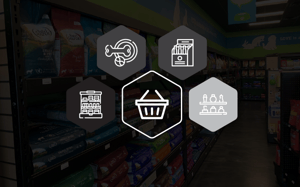American social activist Tom Hayden reportedly said that dogs motivate us to play, be affectionate, seek adventure, and be loyal. You could apply this to many, if not all, pets. It is also why it’s worth putting in extra care when working on your in-store pet category. For many people, their pets are part of their family.
That said, merchandising a pet store can be complicated if you are not familiar with how your consumers shop in the category. Or if you don’t have pets of your own. But that shouldn’t be a concern.Below, we unpack a handful of tips that will help you merchandise your pet store and categories in a fast and efficient way while also showing shoppers that you care about making their shopping experience a pleasant one.

Tip 1: Merchandise according to the lifecycle of the pet
According to CNBC, since the coronavirus pandemic began, purchases relating to pets increased by more than three times than was initially projected in America.
It is further estimated that this increase will continue even after the pandemic as more consumers realize the emotional value and support a pet can provide during difficult times. Thus, merchandising according to the lifecycle of the pet will ease the shopping experience for customers. It will also assist first-time pet owners who might be unsure of where to begin or what to buy.
A life cycle refers to the stages a living organism goes through during its lifespan. It changes from and to each stage can be gradual and slow, depending on the species, breed, and gender.
A pet lifecycle for dogs, for example, is as follows; puppy, adolescent, adult, and senior. Thus for dogs, the recommendation is to merchandise all the products according to this lifecycle. You can merchandise dog food from puppy to senior and then according to the different packaging sizes.
The same principle applies to toys and leashes. You can merchandise toys from smallest to largest and according to the materials used to accommodate the pet's age. For example, your puppy toys would be softer to accommodate their lack of strong teeth while adult dogs will have bigger and harder toys with which to play.
If we look at the general lifecycle of animals, it would be; birth, growth, reproduction, and death. It could be very beneficial to consider these stages when merchandising and even buying new ranges and products.
For example, you could merchandise powdered puppy milk first, then puppy dog food for the unexpected event of a mother dog not being able to produce milk for her puppies.

Tip 2: Do not mix different animal categories
There are five main vertebrate groups alive today - mammals, fish, birds, reptiles, and amphibians. It is crucial to keep these groups together and then subdivide them into categories, subcategories, segments, and sub-segments. Therefore, it is vital to classify your products into a product hierarchy.
Even though different animals and breeds have similar lifecycles and products, it is essential not to mix the categories and confuse your customers.
Of course, you can use the same or similar consumer decision tree (CDT) for different categories to simplify your merchandising. For example, you should keep your cat and dog categories separate even though they go through a similar lifecycle of kittens or puppies, young adults, adults, and seniors.
A good way to keep track of your groupings, categories, subcategories, segments, and sub-segments is by using an end-to-end category management software such as DotActiv Enterprise.
By using data-driven planograms, you can allocate the correct shelf space and shelf share to categories and relevant brands. By connecting these planograms to your floor plan, you can avoid confusion when merchandising the different categories within the different groupings of animals.

Tip 3: Implement cross-merchandising where possible
Cross-merchandising is the retail practice of combining products from different categories together. You can implement cross-merchandising to increase basket size where possible. Also, treating your pet category similarly to a Baby category will assist this tactic as customers usually tend to spend more on their kids and pets than on themselves.
In your pet store or category, you can achieve this by placing excitement-generating products near everyday products.
For example, you could add a clip strip with small toys and bells to the shelf and a gondola with cat food. Therefore, when a customer enters your store to buy cat food, they will spot the toys and might want to treat their pet with a cute toy. You can implement this tactic across all categories as the same principle applies.
Another practical example is to merchandise bowls and feeders next to or close to the relevant pet food. When a customer buys the food, they will realize that they need a new bowl too. This tactic can help increase the basket size of your customers during (and after) the pandemic.

Tip 4: Merchandise “grab and go” products at your till points
“Grab and go” products refer to impulsive purchases. It would usually be in the form of treats, small pet tags, small toys, and cleaning products.
Impulse purchases or impulse buying refers to the situation when a customer purchases something that wasn’t part of their original plan to purchase. This is a tactic used to create awareness of a certain product or brand in the minds of your customers.
A good example of this would be when a customer enters the store to purchase their pet food. Then, when paying, they see pet treats and decide to spoil their pet. They thus buy a product that wasn't on their predetermined shopping list initially.
Another strategy to implement at your checkout point is to showcase discounted, inexpensive, and smaller items. Doing so enables you to create a sense of “missing out” in the minds of your customers. They could think that the next time they visit, the product won’t be on sale anymore and they missed out on the opportunity.
It is also beneficial to merchandise products at the till that you can use for more than one pet category. It provides you with the opportunity to increase your shopper pool and not exclude any potential customers.

Tip 5: Pay attention to your brand flows
Often, brands will supply you with their suggested flows of products.
Even if it is not accurate or you don't plan on using them when merchandising, it is a good practice to take these brand flows into account. Most brands have done extensive research on how customers shop their categories and how to merchandise them for optimized sales. Why wouldn't you want to take advantage of that?
They also have in-depth knowledge of their products and uses for their products, which you might not have.
To create a good flow for your planogram, you must incorporate a mix between your brand flows, your logical product flow, in-store merchandising principles, and your CDT within the category. Often, it won’t be logical to follow a brand flow when you don't merchandise the category by brand but rather by subcategory. In this case, you can still use the brand flow as an indicator for the rest of the category flow.
If your pet store has its own brand name or in-house brand, it is also suggested to give more space to this brand and to merchandise many, if not all, of the other brands in the same way. That allows you to eliminate any unnecessary confusion in the minds of any shoppers who visit your store.
Conclusion
Merchandising a pet store doesn't have to be a struggle if you consider approaching it logically. Do you need help setting up your pet store or need additional merchandising tips? You can book a complimentary custom exploratory consultation with us here or visit our online store.


